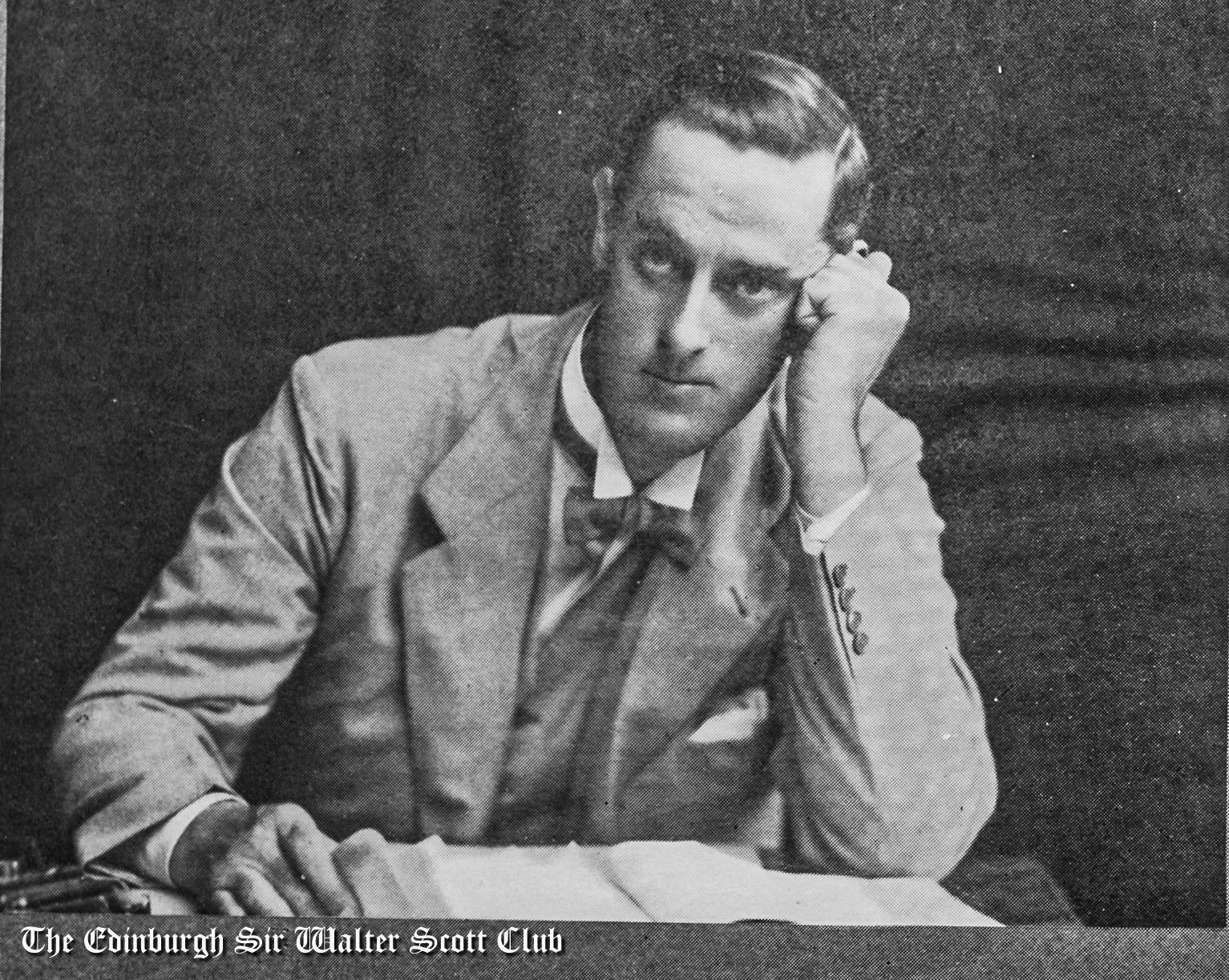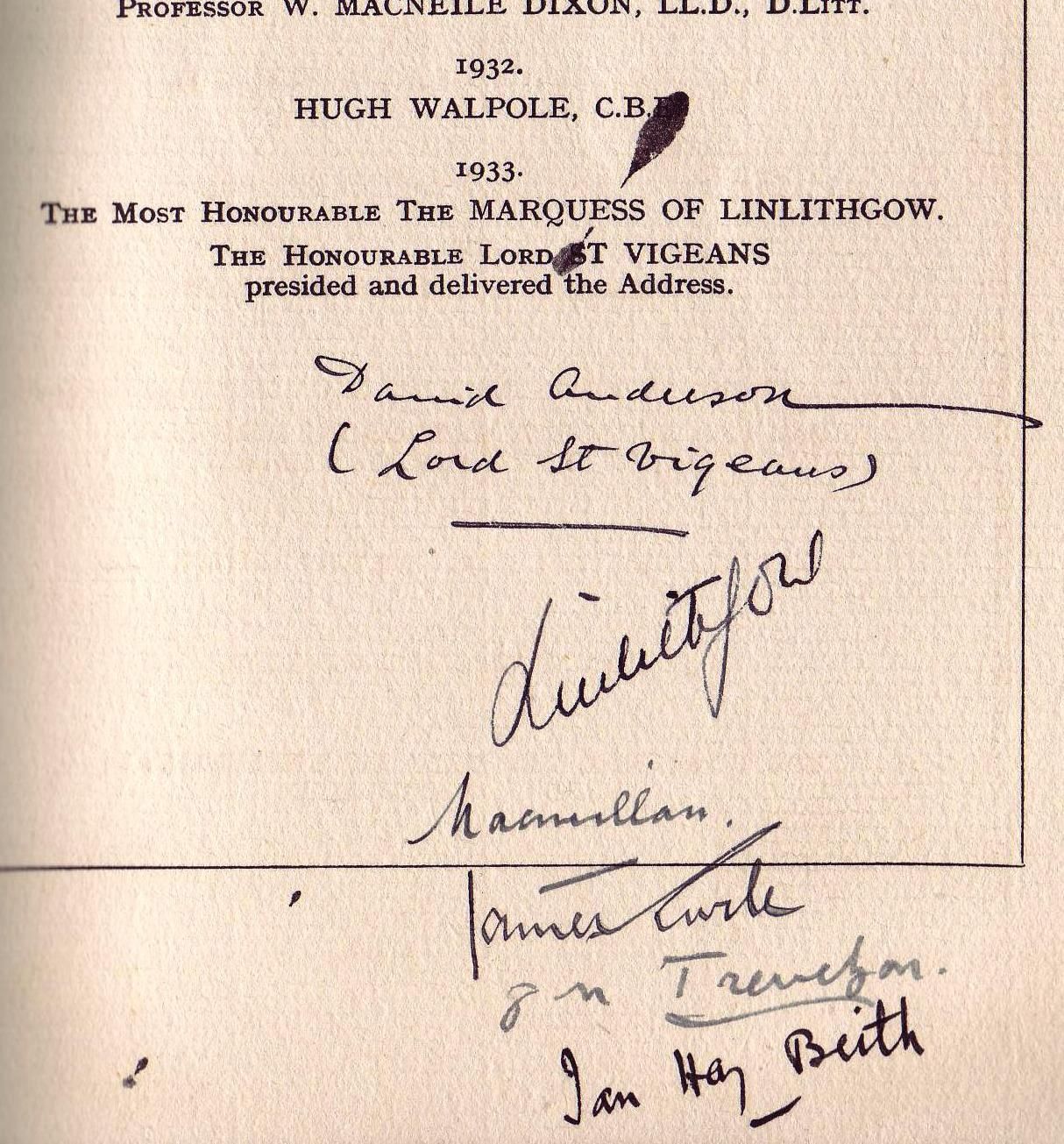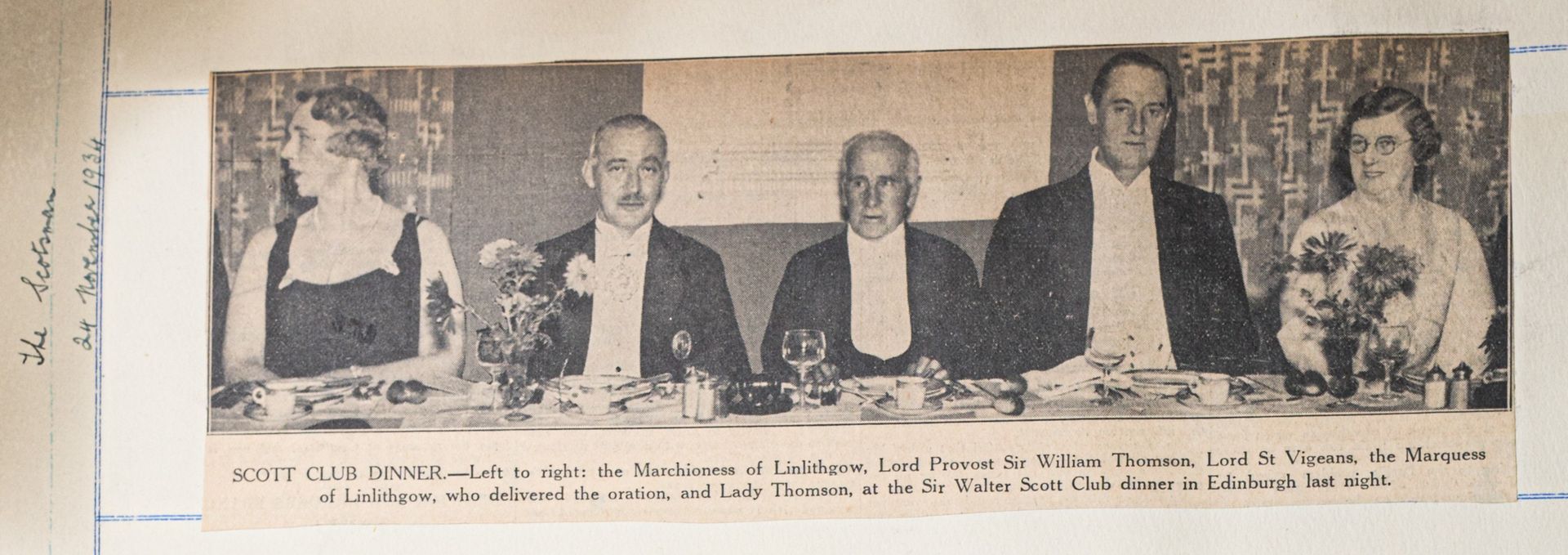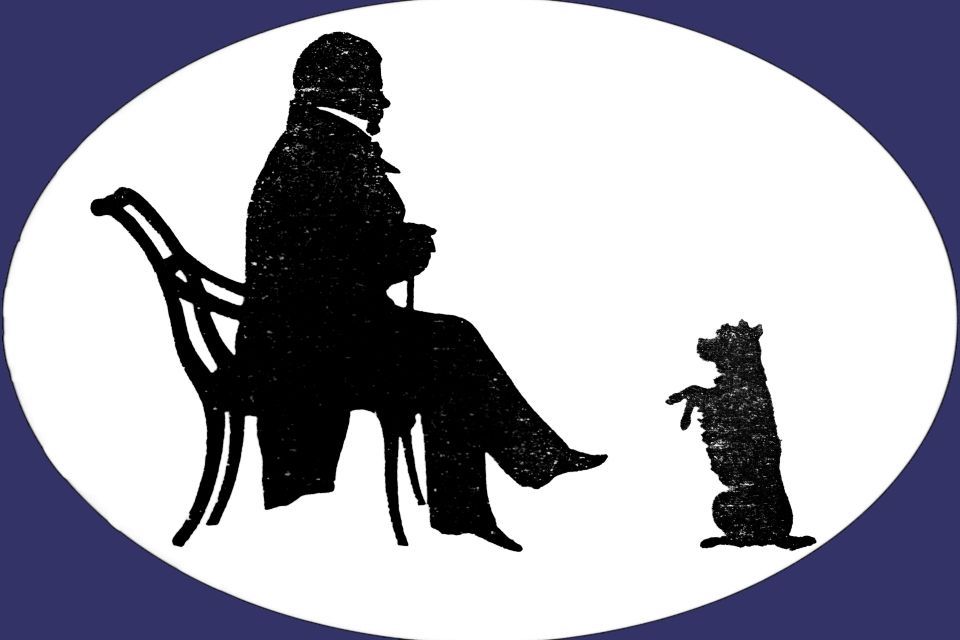1933
Our President in 1933 was:
The Most Hon. The Marquess of Linlithgow
The Hon. Lord St. Vigeans presided and delivered the Toast to Sir Walter at our 34th Annual Dinner on Friday 24th November 1933 in the North British Station Hotel, Edinburgh.
Download the [transcript] or read the [bulletin]
Summary of the Speech:
Lord St Vigeans delivered a highly eloquent and deeply literary tribute to Sir Walter Scott, celebrating both his life and works.
Key Points of the Speech:
1. Scott’s Enduring Legacy
- Lord St Vigeans acknowledged that Scott’s centenary (1832–1932) had been widely commemorated with numerous speeches and tributes.
- He emphasised that even after such an outpouring of admiration, Scott’s spirit still haunted the room, and his works remained a source of joy and inspiration.
2. Scott’s Early Life and Career
- Predestined for Literature: From childhood, Scott’s storytelling talent was evident, evolving from fireside tales to epic historical novels.
- Legal Background: Scott’s training as a lawyer influenced his writing, especially in his understanding of justice, Scottish customs, and historical contexts.
- The Struggle Against Literary Prejudice: At the time, novel-writing was seen as frivolous, and Scott had to overcome the perception that such pursuits were unworthy of a man of law.
3. Scott as the Lawyer and Storyteller
- Though Scott’s legal career never flourished, his legal knowledge shaped much of his work.
- Many of his great novels—"Waverley," "Guy Mannering," "The Heart of Midlothian," "The Antiquary," and "Redgauntlet"—heavily rely on legal themes.
- His detailed knowledge of Scottish law and tradition enriched his historical narratives and characters.
4. Scott’s Mastery of Characterisation
- Scott was celebrated for creating a vast and vivid gallery of characters, second only to Shakespeare.
- He captured the Scottish spirit in his characters, blending chivalry, humour, and realism.
- Favourite Characters Mentioned:
- Jonathan Oldbuck (The Antiquary) – a humorous, eccentric antiquarian.
- Edie Ochiltree – a wise beggar whose philosophy on life was stoic yet profound.
- Meg Merrilies (Guy Mannering) – an iconic prophetess figure who invokes the justice of fate.
- Andrew Fairservice (Rob Roy) – a character filled with caustic humour and self-righteousness.
- Bessie Maclure (Old Mortality) – a tragic yet heroic widow.
- Scott’s use of Scottish dialect added authenticity and charm to his novels.
5. Scott’s Romantic and Chivalric Spirit
- The romanticism of "Ivanhoe" was particularly praised.
- Despite writing it while suffering from illness, Scott infused it with youthful energy and adventure.
- Chivalry and heroism were at the heart of Scott’s writing—his portrayal of knights, battles, and loyalty resonated deeply.
6. Scott’s Personal Qualities
- A Man of Honour: His deep sense of duty, integrity, and love for Scotland defined him.
- Humour and Kindness: Unlike Byron, who was often bitter and cynical, Scott was described as good-humoured and warm-hearted.
- A Scholar and Storyteller: His vast knowledge and love for history and literature made his storytelling rich and immersive.
7. Scott’s Own Life as a Tragic Romance
- Scott’s life was itself a great romance—filled with success, tragedy, and resilience.
- His financial ruin did not break his spirit—he toiled to repay debts, even at the cost of his health.
- Even in old age and decline, Scott remained steadfast in his devotion to Scotland.
8. Scott’s Place in Scottish History
- Lord St Vigeans described Scott’s patriotic spirit, highlighting two key moments:
- Scott’s emotional speech with Lord Jeffrey, where he warned about the erosion of Scotland’s identity.
- Scott’s reaction at the discovery of the Scottish Crown Jewels, where he fiercely defended their sacred significance.
- Scott was compared to Douglas in "Marmion", whose loyalty and honour stood above all else.
9. Scott’s Death and Immortality
- As Scott lay dying at Abbotsford, he was surrounded by the murmur of the River Tweed, the very heart of his beloved Borderland.
- A contemporary tribute from The Spectator (1832) described him as a man of pure spirit, beloved by all, whose memory would never die.
- Scott’s final legacy was summed up in the line: "The Gentleman survived the Genius."
- Thomas Carlyle described Scott as: "A sounder piece of British humanity was not put together in that eighteenth century of time."
Interesting Points Worth Mentioning:
1. The Influence of Law on Scott’s Work
- Scott’s legal background gave him a unique perspective as a novelist.
- His knowledge of Scots law added depth to many of his books, and some of his courtroom and legal scenes remain among the finest in literature.
2. Scott as the ‘Scottish Shakespeare’
- Lord St Vigeans drew parallels between Scott and Shakespeare, particularly in characterisation and dialogue.
- Scott’s novels were so rich in character and human nature that they never grew stale, much like Shakespeare’s plays.
3. Scott’s Deep Connection to Scotland
- Scott was more than just a writer—he was a cultural guardian of Scotland’s traditions and history.
- His emotionally charged moments (like the Crown Jewels incident) showed his deep reverence for Scotland’s past.
4. The Tragic yet Heroic End of Scott’s Life
- Despite crippling debt and declining health, Scott never lost his dignity.
- His final days at Abbotsford, listening to the Tweed, were poignant and poetic, reinforcing the romantic aura surrounding his life.
Conclusion
Lord St Vigeans’ 1933 speech was a sweeping and deeply literary tribute to Sir Walter Scott. It celebrated Scott’s vast contributions to literature, his unwavering patriotism, and his enduring influence on Scottish identity.
Through his novels, poetry, and personal example, Scott shaped Scotland’s cultural and literary landscape, ensuring that his memory would never fade. The speech concluded by invoking Scott’s lasting spirit, calling upon attendees to honour him in solemn silence—a fitting end to a powerful homage.
Download the [transcript] or read the [bulletin]
List of Members Present
The Annual Dinner of the Club was held in the North British Station Hotel on Friday, 24th November 1933, when the Honourable Lord St Vigeans presided over a company of 250. The Croupiers were Mr Kenneth Sanderson, Mr J. H. Thin, and Mr J. J. Herdman. Among those present were Bailie Raithby, Rear-Admiral E. J. Hardman-Jones, Mr J. B. Adshead, Dr W. C. Johnston, D.K.S., Dr James Curle, Mr A. O. Curle, Mr John Clark, Dr Alexander Darling, Dr W. K. Dickson, Sir Joseph Dobbie, Mr William Elgin, Sir Andrew Grierson, Dr King Gillies, Mr R. Gemmell Hutchison, R.S.A., Dr H. W. Meikle, Mr James Milligan, Dr J. R. Peddie, Dr James Watt, Mr William Watt, Honorary Secretary, and Mr Alexander Laurie, Honorary Treasurer.

Subsidiary Toasts Summary.
- "The King" and "The Royal Family" toasts were formally honoured as part of the tradition.
- Toast to "The Imperial Forces" (proposed by Lord St Vigeans):
- Stressed the Imperial Forces as symbols of freedom and the defence of sacred rights.
- Quoted John Barbour’s The Brus and mentioned how Walter Scott embodied martial spirit.
- Coupled the toast with Rear-Admiral E.J. Hardman-Jones, representing the Navy.
- Rear-Admiral Hardman-Jones, replying, emphasised:
- Importance of unity among the Navy, Army, and Air Force.
- Concerns over disarmament talks leading to a false sense of security.
- The need for maintaining strong forces to protect trade routes and the Empire.
- The value of military training for national character and strength.
- Toast to "The City of Edinburgh" (proposed by Dr King Gillies):
- Celebrated Edinburgh’s progress from Scott’s time to the modern day.
- Imagined how Scott would marvel at the National War Memorial and the city’s educational growth.
- Playfully imagined Scott encountering modern women (like Jeanie Deans and Madge Wildfire) in new societal roles.
- Praised Edinburgh’s balance of romance, tradition, progress, and humanitarian leadership.
- Coupled the toast with Bailie Raithby, who replied:
- Reflected on his childhood fascination with Scott.
- Emphasised Scott’s contribution to Edinburgh’s literary and cultural fame.
- Warned against prioritising commercialism over preserving Edinburgh's unique heritage.
- Toast to "The Chairman" (proposed by Mr William C. Johnston):
- Praised Lord St Vigeans for his knowledgeable and heartfelt speech about Scott.
- Highlighted his legal background aiding his understanding of Scott’s mind and works.
- Chairman’s Response (Lord St Vigeans):
- Humble about the difficulty of summarising Scott’s life and works in one speech.
- Praised the outgoing secretary Mr Milligan for 12 years of service.
- Welcomed incoming secretary Mr William Watt.
- Entertainment:
- Mr John Tainsh performed songs accompanied by Mr J.W. Cowie.
Interesting Points:
- The Toast to the Imperial Forces was unusually candid for a dinner speech—highlighting real anxieties about British military weakness and disarmament just a few years before WWII.
- A strong emphasis on unity across the Services – an early hint at later integrated defence thinking.
- Dr King Gillies' playful imagination of Sir Walter Scott encountering modern Edinburgh was charming: from women playing golf to educational expansion—using humour to contrast eras.
- Bailie Raithby’s speech touched poignantly on whether Scott would still find a welcome in increasingly commercialised Edinburgh—a sentiment that still feels relevant today.
- The outgoing secretary, Mr Milligan, served from 1921–1933, and before him Mr Kenneth Sanderson served from 1894—impressively showing the Club’s stability and loyalty.
Download the [Subsidiary Toasts] to read in full.

The signatures on the
[1934 bulletin] are:
David Anderson (Lord St. Vigeans) gave the address in 1933, & became president in 1934, when the Marquess of Linlithgow made the address.
Macmillan is the Right Hon. Lord Macmillan who became president in 1935, James Curle became president in 1936, Professor George Trevelyan in 1937, and
Major General John Hay Beith (the popular writer who used the pseudo. Ian Hay) who became president in 1938.



